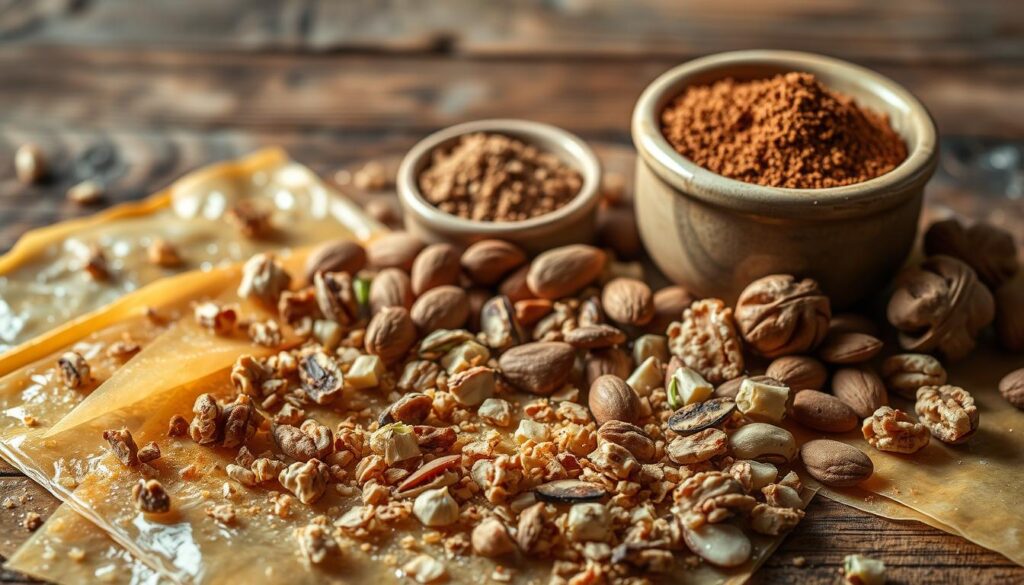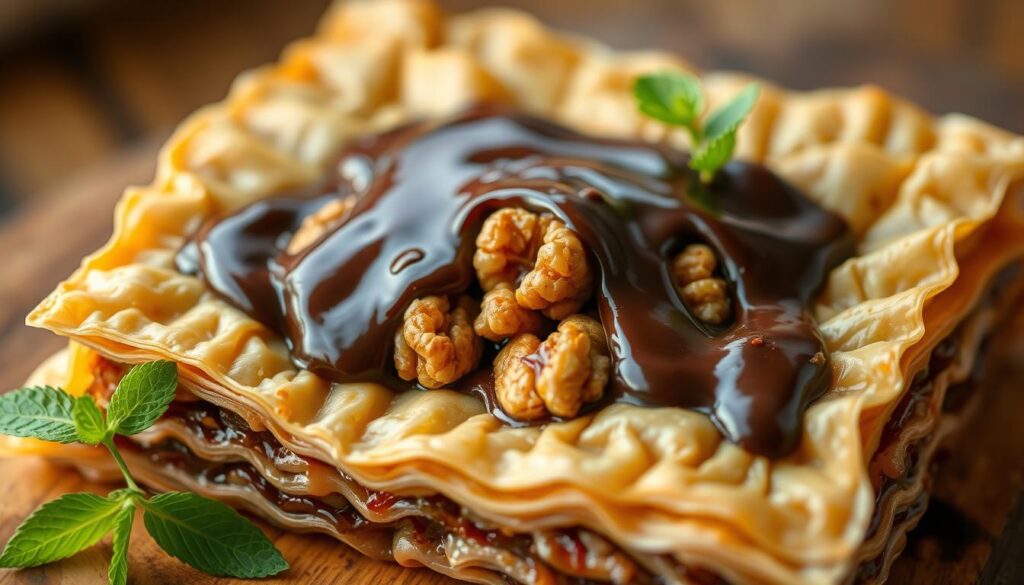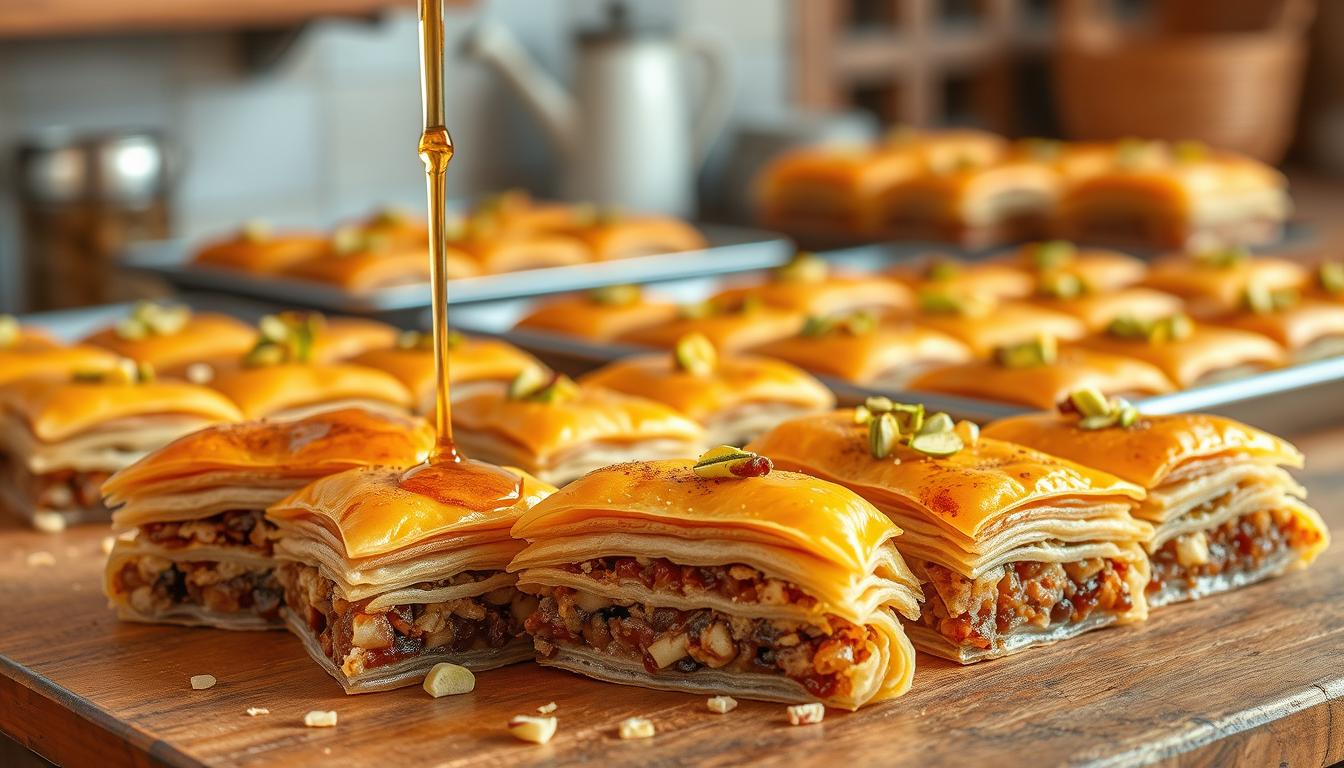Are you ready to indulge in a sweet treat that has been a staple of Middle Eastern cuisine for centuries? Baklava, a rich and nutty pastry, has been tantalizing taste buds with its diverse flavors and textures.
From traditional recipes passed down through generations to innovative creations that push the boundaries of this beloved dessert, the world of baklava is full of surprises. Whether you’re a food enthusiast or just looking to satisfy your sweet tooth, exploring the various tasty baklava dessert variations will elevate your culinary experience.
Key Takeaways
- Explore traditional and innovative baklava recipes
- Discover the rich flavors and textures of this beloved dessert
- Learn about the diverse variations of baklava from around the world
- Find inspiration for your next culinary creation
- Indulge in the sweet and nutty goodness of baklava
The Origins of Baklava and Its Evolution
The rich history of baklava is a testament to its enduring appeal across cultures. This dessert, known for its layers of flaky pastry, nuts, and sweet syrup, has a story that spans centuries and traverses multiple continents.
Baklava’s history is complex, with its exact origin disputed among food historians. However, it is widely believed that baklava originated in the ancient civilizations of Mesopotamia, a region that corresponds to modern-day Iraq, parts of Turkey, and Syria. The dessert was likely influenced by the Assyrians, who layered nuts and honey on bread as early as the 8th century BC.
Historical Background of Baklava
The evolution of baklava continued through the Roman and Byzantine empires, with the dessert becoming a staple in Mediterranean cuisine. The modern version of baklava, with its characteristic layers of phyllo dough, emerged during the Ottoman Empire. The Topkapi Palace in Istanbul, once the seat of the Ottoman sultans, is said to have played a significant role in the development of baklava as we know it today.
The dessert’s popularity spread throughout the Middle East, Greece, and other parts of the Mediterranean, with each region adapting baklava to its own tastes and traditions. This cultural exchange not only influenced the ingredients used in baklava but also its preparation methods and presentation.
Cultural Significance Across Regions
Baklava has become an integral part of various cultural celebrations and traditions. In Greece, it is a staple at weddings and holidays, symbolizing good fortune and prosperity. In Turkey, baklava is often served during special occasions such as weddings and Ramadan. The dessert’s significance extends beyond its taste, representing hospitality, generosity, and community bonding.
The diverse ways baklava is enjoyed across cultures highlight its versatility and the creativity it inspires. From the use of different nuts and spices to variations in the syrup and phyllo dough, baklava’s adaptability has contributed to its enduring popularity. As a result, baklava remains a beloved dessert around the world, with its rich history and cultural significance continuing to inspire new flavorful baklava ideas and traditional baklava variations.
Classic Baklava: The Traditional Recipe
For those looking to try their hand at homemade baklava options, the traditional recipe is a great place to start. This classic dessert has been a staple in many cultures for centuries, and its enduring popularity is a testament to its timeless appeal.
The traditional baklava recipe is characterized by its simplicity and the quality of its ingredients. At its core, baklava consists of layers of flaky phyllo dough, a mixture of nuts, and a sweetener, typically honey syrup.
Ingredients in Traditional Baklava
The ingredients used in traditional baklava are straightforward yet crucial to achieving the perfect balance of flavors and textures. The primary components include:
- Phyllo dough: This is the foundation of baklava, providing the layers that give the dessert its signature flakiness.
- Nuts: Walnuts, pistachios, or almonds are commonly used. The choice of nut can significantly affect the flavor profile.
- Honey syrup: A mixture of honey, sugar, and water, this syrup is what gives baklava its sweetness and a hint of stickiness.
- Spices: Some recipes include spices like cinnamon or cardamom to add depth to the nut mixture.

Step-by-Step Preparation
Preparing traditional baklava is a multi-step process that requires some patience but yields rewarding results. Here’s a simplified guide:
- Prepare the phyllo dough according to the package instructions or make it from scratch.
- Mix the chosen nuts with any desired spices.
- Layer the phyllo dough, brushing each layer with butter, and interspersed with the nut mixture.
- Cut the baklava into diamond or square shapes before baking until golden.
- While the baklava is baking, prepare the honey syrup by boiling the honey, sugar, and water mixture until it thickens slightly.
- Once the baklava is done, remove it from the oven and immediately pour the hot honey syrup over it.
By following these steps and using high-quality ingredients, you can create a best baklava recipe that is sure to impress. Whether you’re making it for a special occasion or simply to satisfy a sweet craving, traditional baklava is a dessert that’s hard to resist.
Nutty Delights: Popular Nut Varieties in Baklava
Nuts are the backbone of baklava, providing texture, flavor, and nutritional value. The selection of nuts can significantly impact the overall character of this beloved dessert. As we explore the world of baklava, it becomes clear that the type of nuts used is a defining feature.
“The art of choosing the right nuts is crucial in creating the perfect baklava,” says a renowned pastry chef. This statement underscores the importance of nuts in baklava’s overall appeal.
Pistachios: A Premium Choice
Pistachios are often considered the gourmet choice for baklava due to their mild, nutty flavor and vibrant green color. They add a subtle elegance to the dessert, making it a popular choice for special occasions. The use of pistachios in baklava is particularly prevalent in Middle Eastern cuisine, where they are valued for their unique flavor profile.
Pistachios also offer a delicate crunch that complements the layers of flaky pastry in baklava. Their mild flavor allows the other ingredients, such as honey and spices, to shine while still providing a satisfying nutty taste.
Walnuts: A Rustic Flavor
Walnuts, on the other hand, bring a robust and earthy flavor to baklava. They are often used in traditional recipes and are prized for their rich, slightly bitter taste. Walnuts add depth and complexity to the dessert, making it a hearty and satisfying treat.
The use of walnuts in baklava is widespread, particularly in Greek and Turkish variations. Their bold flavor pairs well with the sweetness of the syrup, creating a balanced and delicious dessert.
In conclusion, the choice between pistachios and walnuts in baklava ultimately comes down to personal preference. Both nuts offer unique characteristics that enhance the dessert in different ways. Whether you’re drawn to the elegance of pistachios or the rustic charm of walnuts, there’s a baklava variation out there to suit every taste.
Sweet Suggestions: Unique Syrups and Fillings
Discover the art of crafting innovative baklava variations with unique syrups and fillings that are sure to impress. Traditional baklava is undeniably delicious, but experimenting with different flavors can elevate this dessert to new heights.
One of the key elements in creating delicious baklava twists is the syrup. While honey syrup is a traditional choice, other options can add a fascinating twist to the classic recipe.
Honey Syrup: The Sweet Standard
Honey syrup has been the traditional sweetener for baklava, providing a rich, caramel-like flavor that complements the nuts and phyllo dough. Its viscosity and sweetness level make it an ideal choice for balancing the flavors in baklava.
Rose Water: A Floral Touch
For those looking to add a floral dimension to their baklava, rose water is an excellent choice. This fragrant ingredient can be used to create a syrup that adds a subtle, flavorful baklava idea to the traditional dessert.
Rose water baklava is particularly popular in Middle Eastern cuisine, where the floral notes are appreciated for their delicate flavor and aroma.
Orange Blossom: Citrus Notes
Another fragrant option for baklava syrup is orange blossom water. This ingredient introduces a citrusy note that can beautifully contrast with the richness of the nuts and honey.
Using orange blossom water in baklava creates a unique flavor profile that’s both refreshing and sophisticated, making it perfect for those seeking delicious baklava twists.
By incorporating these unique syrups and fillings into your baklava recipe, you can create flavorful baklava ideas that are sure to delight your taste buds and impress your guests.
Health-Conscious Baklava: Guilt-Free Options
With a few simple tweaks, baklava can be transformed into a healthier dessert option that still satisfies your cravings. By making a few conscious choices in ingredients and preparation methods, you can enjoy this beloved dessert without compromising on nutrition.
One of the primary ways to make baklava healthier is by altering the type of pastry used. Traditional phyllo dough is typically made from refined flour, which can be high in empty calories and low in nutritional value. A healthier alternative is to use whole wheat pastry, which is higher in fiber and nutrients.
Whole Wheat Pastry Variations
Using whole wheat pastry is a straightforward way to increase the nutritional value of your baklava. Whole wheat flour contains more fiber, vitamins, and minerals compared to refined flour. This substitution not only makes the pastry healthier but also adds a nutty flavor that complements the nuts and spices in baklava.
To make whole wheat phyllo dough, you can replace refined flour with whole wheat flour in your recipe. Keep in mind that whole wheat flour can be denser, so you may need to adjust the liquid content accordingly. Some recipes also suggest combining whole wheat with other ancient grains like Kamut or spelt for added nutrition and flavor.
“The key to a healthy dessert is balance. By incorporating nutritious ingredients and being mindful of portion sizes, you can enjoy your favorite treats without guilt.”
Natural Sweeteners: Maple and Agave
Another way to make baklava healthier is by using natural sweeteners instead of refined sugar. Maple syrup and agave nectar are popular alternatives that not only reduce the glycemic index of the dessert but also add unique flavors.
Maple syrup, for instance, contains minerals like manganese and zinc, making it a slightly healthier option than refined sugar. Agave nectar has a lower glycemic index, which means it digests more slowly and won’t cause a sudden spike in blood sugar levels.
| Natural Sweetener | Glycemic Index | Mineral Content |
|---|---|---|
| Maple Syrup | 54 | Manganese, Zinc |
| Agave Nectar | 15-30 | Trace minerals |
| Refined Sugar | 65 | Minimal |
When using natural sweeteners, it’s essential to remember that they are still high in calories. Moderation is key to enjoying baklava as a healthier dessert option.
By incorporating whole wheat pastry and natural sweeteners into your baklava recipe, you can create a dessert that is both delicious and nutritious. Experiment with different ingredients and flavor combinations to find your perfect guilt-free baklava.
Chocolate Lovers Unite: Baklava with a Twist
For those who can’t get enough of chocolate, baklava offers a new playground for creativity. The traditional layers of phyllo, nuts, and honey can be elevated with the richness of chocolate, creating gourmet baklava creations that are both familiar and innovative.
The combination of chocolate and baklava may seem unexpected, but it’s a match that has been gaining popularity among dessert enthusiasts. By incorporating different types of chocolate into the traditional baklava recipe, bakers can create delicious baklava twists that appeal to a wide range of tastes.
Dark Chocolate Drizzled Baklava
One of the simplest yet most effective ways to combine chocolate with baklava is by drizzling dark chocolate over the top layer. The bitterness of the dark chocolate complements the sweetness of the honey and the crunch of the nuts, creating a delightful contrast of flavors.
Dark chocolate, with its high cocoa content, adds a level of sophistication to the traditional baklava. It’s a great way to enhance the dessert without overpowering its original characteristics.

Chocolate Hazelnut Baklava Bites
Another creative approach is to make Chocolate Hazelnut Baklava Bites. These bite-sized treats involve layering phyllo dough with hazelnuts and chocolate, then baking until golden. The result is a delicious fusion of flavors and textures that’s perfect for snacking or as a dessert.
The use of hazelnuts adds a nutty flavor that pairs well with chocolate, while the phyllo dough provides a satisfying crunch. These bites are not only delicious but also visually appealing, making them a great option for parties or special occasions.
| Chocolate Type | Baklava Variation | Description |
|---|---|---|
| Dark Chocolate | Drizzled Baklava | Bitterness of dark chocolate complements the sweetness of honey |
| Milk Chocolate | Chocolate Hazelnut Bites | Sweet and creamy, pairs well with hazelnuts |
| White Chocolate | White Chocolate Baklava | Sweet and creamy, provides a nice contrast to traditional baklava |
Fusion Baklava: Creative Global Influences
Fusion baklava is revolutionizing the world of desserts with its creative global influences. This innovative approach to a traditional dessert involves combining different international flavors and ingredients to create something entirely new and exciting.
The beauty of baklava lies in its versatility, allowing it to be reimagined with various global flavors. From the subtle bitterness of matcha to the spicy kick of Mexican chocolate, these unique baklava flavors are sure to tantalize taste buds.
Matcha Baklava: A Japanese Twist
Matcha baklava brings a Japanese twist to the traditional dessert. The bitterness of matcha is balanced by the sweetness of the honey syrup, creating a delightful flavor contrast. This variation is perfect for those looking for a unique and refreshing dessert experience.
Matcha, with its bright green color and distinct flavor, adds an exciting dimension to the classic baklava. The use of matcha in baklava is a great example of how traditional desserts can be innovatively reimagined.
Mexican Chocolate Baklava: Spicy and Sweet
Mexican chocolate baklava combines the richness of chocolate with the warmth of spices like cinnamon and chili. This spicy and sweet variation is a perfect blend of Mexican and Middle Eastern flavors, creating a truly unique dessert experience.
The addition of chili peppers gives this baklava a bold and spicy kick, making it a great choice for those who enjoy a little heat in their desserts. The combination of flavors in Mexican chocolate baklava is a testament to the versatility of baklava and its ability to be paired with a wide range of ingredients.
| Fusion Baklava Variation | Key Ingredients | Flavor Profile |
|---|---|---|
| Matcha Baklava | Matcha powder, honey syrup | Bitter, sweet |
| Mexican Chocolate Baklava | Mexican chocolate, cinnamon, chili peppers | Spicy, sweet, rich |
These flavorful baklava ideas showcase the potential of fusion cuisine in creating exciting and unique desserts. By combining different global flavors and ingredients, baklava can be transformed into a wide range of delicious variations.
Seasonal Baklava: Celebrating Holidays and Occasions
Celebrating holidays and special occasions becomes even sweeter with seasonal baklava variations that incorporate festive flavors. Baklava, a versatile dessert, can be tailored to match the spirit and tastes of various celebrations throughout the year.
By incorporating seasonal ingredients and spices, you can create unique baklava recipes that are perfect for special gatherings. Whether it’s the warmth of fall, the chill of winter, or any other season, baklava can be reimagined to delight your guests.

Pumpkin Spice Baklava for Fall
As fall arrives, the flavors of pumpkin spice become a staple of the season. Incorporating these warm spices into baklava creates a delightful twist on the traditional recipe. Pumpkin spice baklava combines the classic layers of phyllo dough and nuts with the comforting flavors of cinnamon, nutmeg, and ginger.
To make pumpkin spice baklava, simply add pumpkin puree and the appropriate spices to your baklava filling. This not only adds moisture but also infuses the dessert with the cozy feelings associated with fall.
Peppermint Baklava for Winter Celebrations
Winter celebrations, such as Christmas and New Year’s, are the perfect occasions for peppermint baklava. The refreshing zing of peppermint complements the richness of the nuts and phyllo dough, creating a delightful contrast of flavors.
To create peppermint baklava, you can incorporate peppermint extract into the syrup or sprinkle crushed peppermint candies on top of the baklava before baking. This gives the dessert a festive touch and a cooling flavor that’s perfect for the winter season.
Experimenting with seasonal flavors and ingredients is a great way to keep your baklava recipes fresh and exciting. Whether you’re celebrating a holiday or simply want to enjoy the tastes of the season, tasty baklava dessert variations like pumpkin spice and peppermint baklava are sure to impress.
By embracing the best baklava recipes and adapting them to the season, you can make this traditional dessert a highlight of your celebrations. So, don’t be afraid to get creative and try out new seasonal baklava variations.
Serving Suggestions: Pairing Baklava with Beverages
Elevate your baklava experience by pairing it with the perfect beverage. Gourmet baklava creations offer a diverse range of unique baklava flavors that can be complemented by various teas and coffees, enhancing the overall dessert experience.
Perfect Tea Matches
For a traditional pairing, consider serving baklava with a strong black tea, such as Earl Grey or English Breakfast. The bergamot flavor in Earl Grey complements the nutty flavors found in baklava, while English Breakfast provides a robust contrast to the sweetness.
Coffee Pairings to Savor
Coffee lovers can enjoy baklava with a rich, bold coffee. A Turkish coffee pairs well with the spices and nuts in traditional baklava, while a flavored coffee like hazelnut can enhance the dessert’s overall flavor profile.
By choosing the right beverage to pair with your baklava, you can create a harmonious and satisfying culinary experience that showcases the versatility of gourmet baklava creations and unique baklava flavors.


